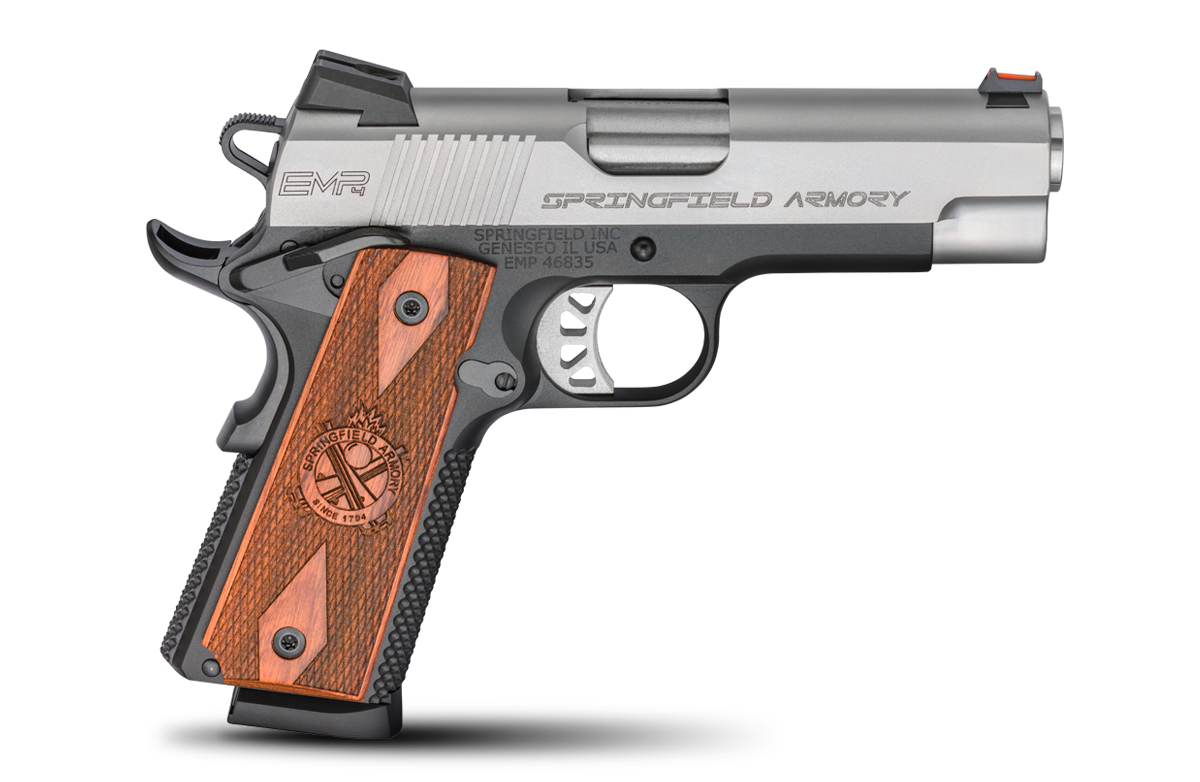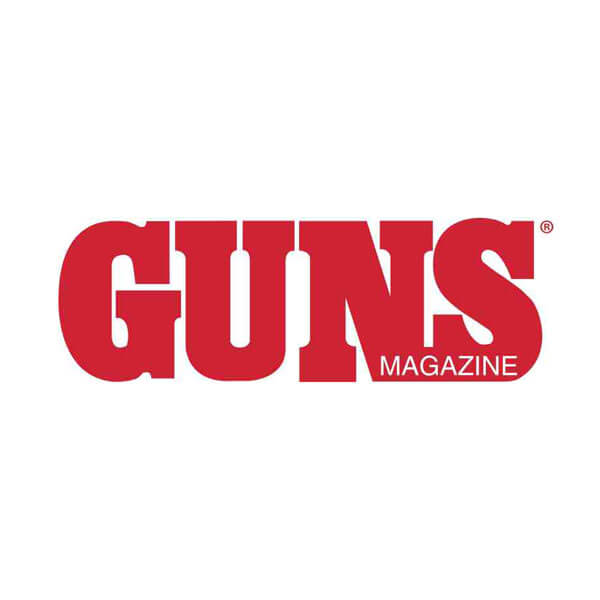A Handful of Compact Firepower
April 12th, 2020
9 minute read
A lot of engineering has gone into “shoehorning” the 9mm Luger into the 1911 frame designed for the .45 ACP. The simplest solution (albeit initially the most expensive!) is the one Springfield Armory pursued in the EMP series. By reducing the size of the frame to fit the OAL of 9mm-class cartridges, they created an arm offering a firmer grip for average hands than with the larger .45 version.
Another plus? No more obsessing over magazine construction and wondering whether blocking the magazine at front or back is preferable. An even bigger plus from a CCW standpoint is now the pistol is no bigger than it need be to handle 9mm (or .40 SW) cartridges.
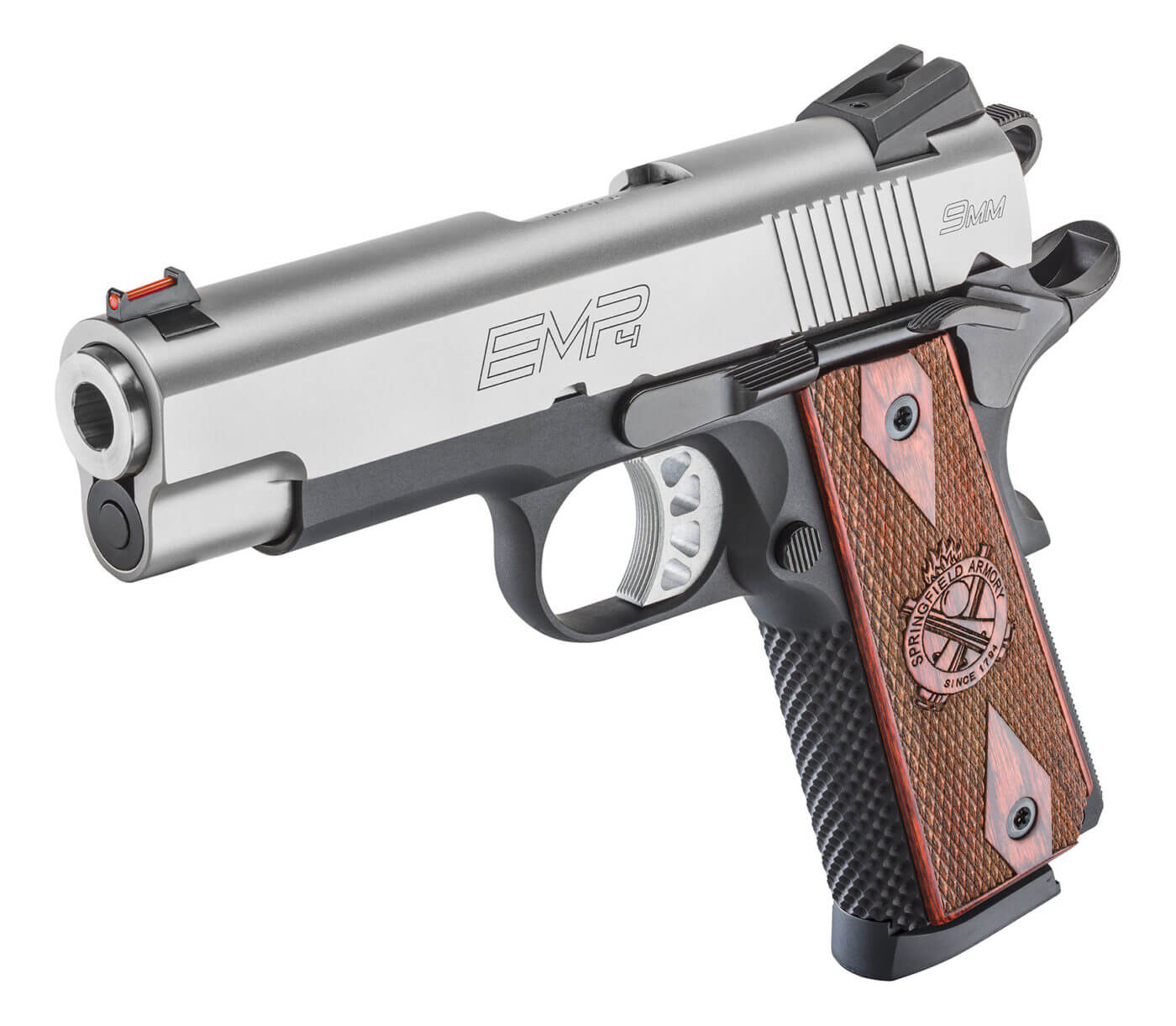
Ergonomic Assessment
The slim wood grips are delightfully flat (held by flat-black Torx screws) and the new EMP4 frame is 1/2″ longer than the 3″ version. The EMP4 is more like a full-size gun — still very concealable — and fits my hand better. The single-stack magazine holds an extra round over the shorter EMP for a capacity of 10+1. The frontstrap has Springfield’s “Posi-Lock” grip texture. It feels great and isn’t too sharp, allowing you to move your hand if need be without discomfort, yet gives you a solid no-slip grip in shooting. The mainspring housing is also finely checkered for a solid grip, too, and is equally comfortable.
Perception is important, especially if you can’t shoot a gun before buying it. My immediate take on the EMP4 when removing it from the box was one of confidence — a feeling reinforced at the range. The reduced grip circumference is all at the frontstrap, so trigger reach is no different from what it would be on a standard 1911. My trigger finger rests squarely across the face of the trigger (as it does with a full-size 1911), but my ability to grasp the pistol seems to be enhanced. I really had the feeling the EMP4 was locked into my hand. Again, this perception was confirmed on the range.
The balance of the 4″ barrel over the longer aluminum frame is about perfect, allowing a steady aim. The EMP4 has a straight-tube heavy barrel, also aiding a rock-steady hold on target. As to weight, the EMP4 weighs 1/2-ounce more than my Colt .38 Super Lightweight Commander (both arms unloaded). All the extra weight is in the barrel and the EMP4 is of the “bushingless” 1911 configuration.
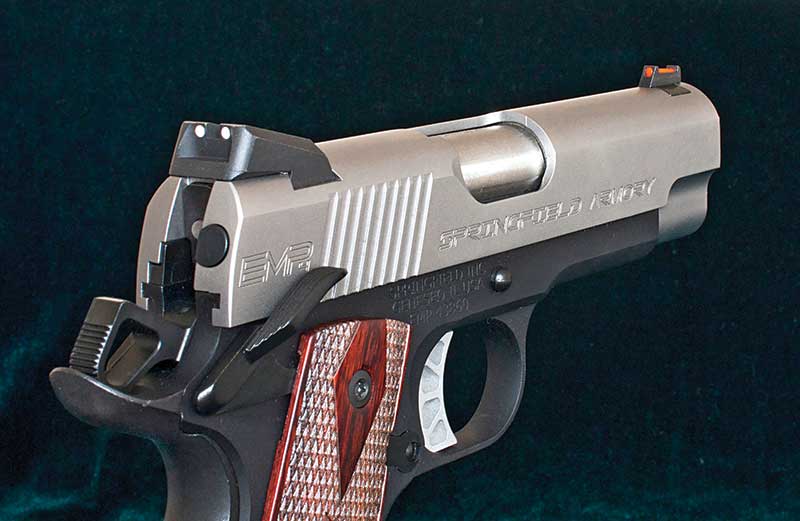
Sights, Slide, Safety
The rear sight is a Novak low-profile style, with two white-paint-filled dots. The front is red fiber optic, and the gun comes with a spare red rod and a green rod. Both front and rear sights are set in dovetails and the rear is adjustable for windage, locked down by a setscrew.
You may have read about how fiber-optic front sights flare too brightly for us older, crabbier shooters (like me) to see well. To mitigate the problem, I just run a black Sharpie marking pen over it. Now the front sight just glows red in daylight and the problem is solved. The Sharpie ink wipes away with a little dab of mineral spirits or rubbing alcohol.
The slide is easy to rack, even with the hammer at rest. The slide serrations are angled and give a solid grip. The width of the slide is nearly the same as my Colt Commander (another plus: the EMP4 fits all my Commander holsters well). The slide stop is the same distance from my thumb as on a full-size 1911.
The safety is ambidextrous and, unlike many, there is no perceptible play in the right side lever. The safety requires little pressure to apply or disengage and — more importantly — it’s not mushy. It does not move until you push it “off” or “on” with an audible click.
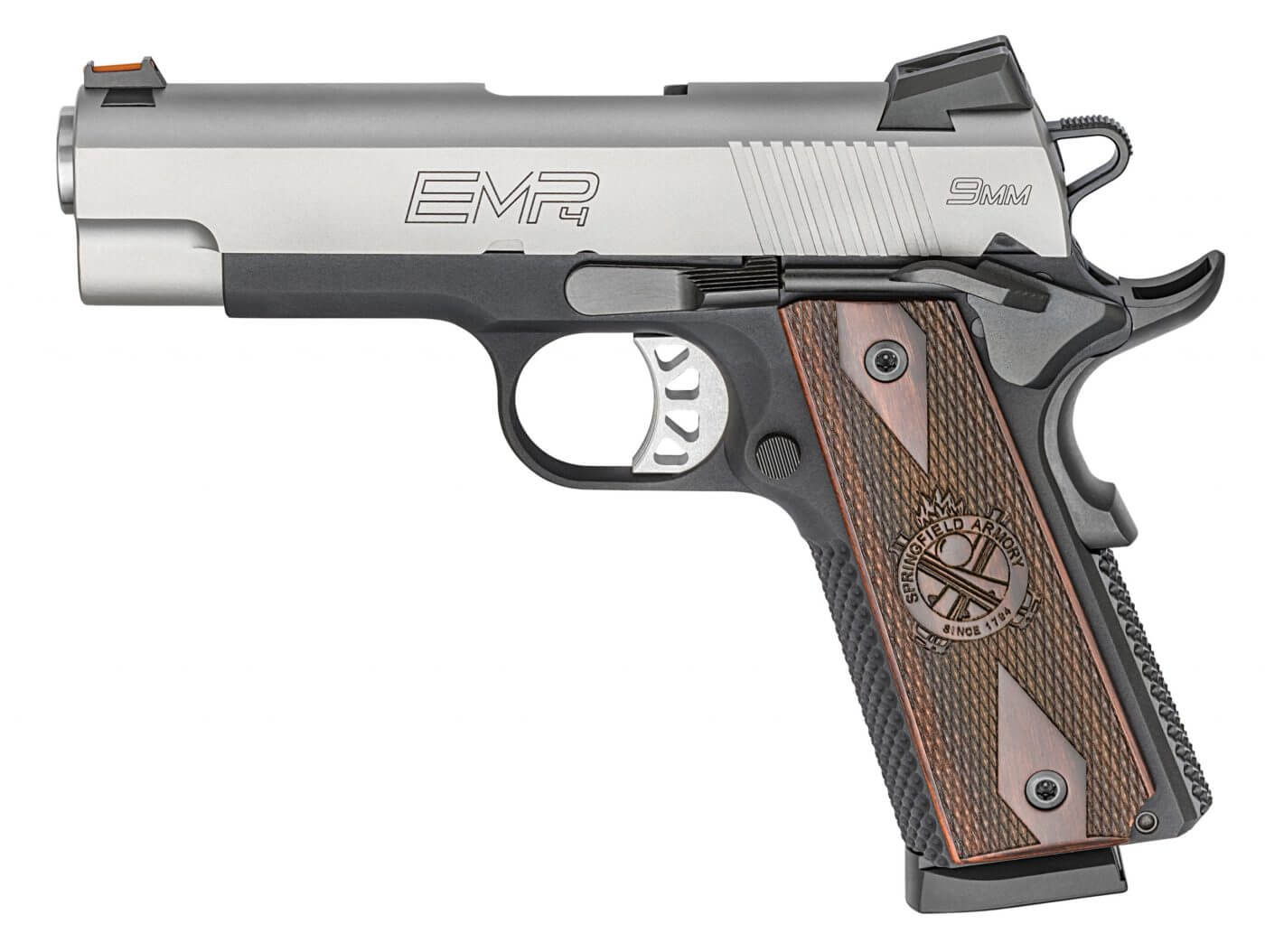
The grip safety has a memory pad at the base to ensure you have it depressed when firing. The generously curved upper portion guides the web of your hand during the draw. The grip safety shows excellent fitting around the frame contour. The fit of the slide-ejector-to-frame at the back is superb. These handsome touches are usually only found on expensive custom pistols and indicate nice attention to detail on a factory gun.
The hammer is the currently fashionable “hollowed Commander style” and is well serrated on top. It nestles inside a notch on the grip safety and is easy to thumb cock or uncock. The trigger travels smoothly about 1/16″ before it stops and breaks cleanly at 4 lbs. on the nose. There’s no overtravel adjustment, and this trigger didn’t need it.
The magazine well is gently flared, and magazines go in easily. A pad on the floorplate adds 3/8″ to the length of the magazine (and overall pistol height) to ensure full seating on insertion and cushions the mag’s fall when it hits the ground. Magazines, incidentally, drop free when the button is pressed. The release is much closer to my thumb than on a standard-width 1911. I don’t have to shift my grip to press it.
The button release itself is nicely serrated and has a rather heavy spring compared to other 1911s. I doubt there is a chance of it being dropped accidentally. The magazines have no holes for round-counting and I’m not sure they are necessary — just another entry point for dirt and dust. The magazines (made by Mec-Gar) are nicely blued and the follower is of the round-top type.
Speaking of magazines, when Springfield started this project, there was a short-action family consisting of the 9mm Luger, .40 SW (both offered in the EMP3 and now the EMP4) and .45 GAP. Initially, Springfield planned on all three, but the GAP proved problematic and, since the cartridge never got off the ground anyway, it was abandoned (although the magazine well is wide enough to accommodate a .45 GAP-width magazine). The EMP4 9mm magazine has the width-reducing ribs familiar to shooters of full-size .38 Super and 9mm 1911s.
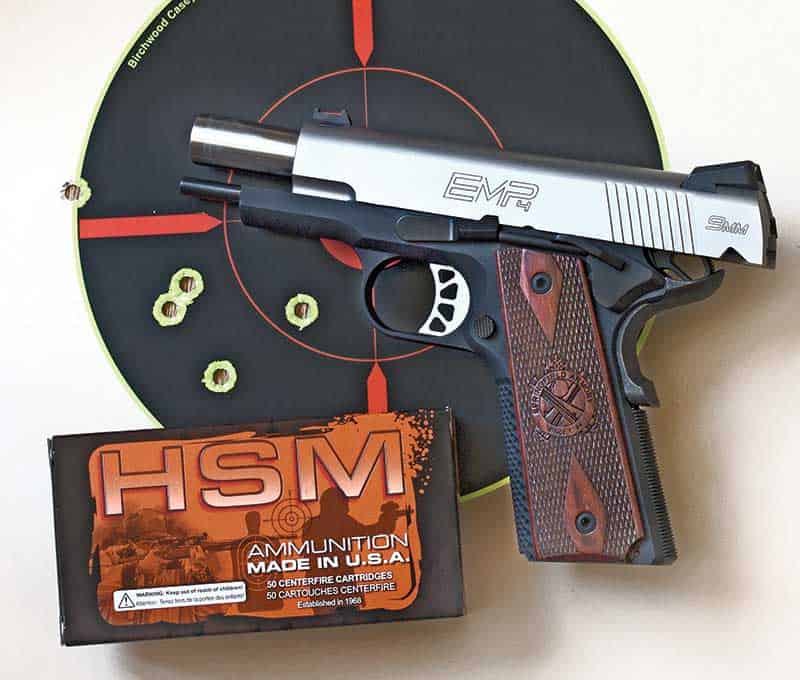
Rounds Downrange
The EMP4 looks pleasantly clean and streamlined, sporting none of the modern contrivances such as light rails, squared and checkered triggerguard, or clumsy, high-profile sights. The gun is small, light and has few snag points. It looks smaller than it actually is, and I mean that as a tribute.
Feeding from the start was flawless. My initial session in the desert involved just over 100 rounds of American Eagle FMJ, shooting offhand at an informal target. I usually like to get a feel for a new gun first, which is why I start the test with FMJ ammo. I don’t have to make any “break-in” excuses here. The EMP4 ran like a top from the start.
Accuracy was very good, although after the first sit-down accuracy evaluation, I thought the pistol might be suffering from the “1st shot” syndrome, where the hand-cycled 1st round shoots wide, but I concluded it was my fault. On the second visit to verify this, I loaded the magazine with 10 rounds and shot on two different targets. Since several of the loads shot close to the sights, I could see the rounds splash using Birchwood Casey Shoot-N-C targets. The difference in group sizes between the two targets with all the loads was minimal. So I have no excuses for the wider shots in the groups. They were all definitely caused by the loose nut behind the trigger, and not attributable to the “1st shot syndrome.”
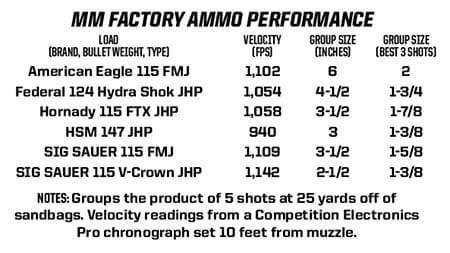
Of the loads tried, all were reliable and no stoppages occurred over several range visits. Intervals between my shooting sessions were considerable as active spring and summer thunderstorms seemed to fall on the days I could shoot. I cleaned the gun twice between these sessions with Prolix and an Otis Pull Through, wiping the rest clean with Prolix-soaked patches. I used FP-10 for the slide-rail lubricating chores.
The HSM 147-grain JHP load shot closest to the sights and SIG SAUER ammo took the accuracy crown. I recorded the accuracy from 5-shot groups and, taking a page from Mas Ayoob’s book, included the accuracy of the best 3. I did so more because my eyes seem to tire faster shooting handguns these days. Either that or my attention span is as short as my eyesight. I’m sure it’s one or the other! Probably both…
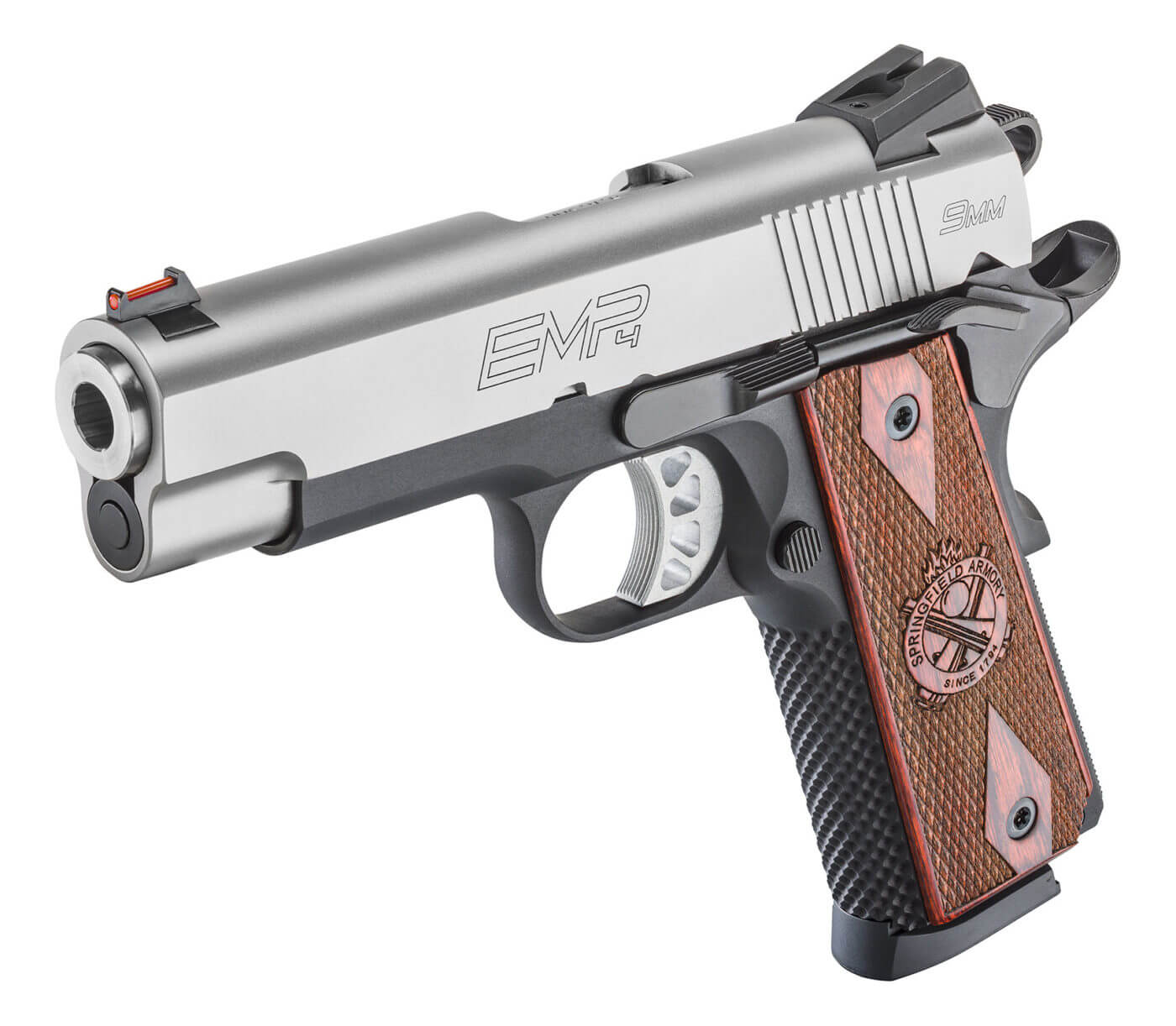
Mystery Solved
Around the 450- to 500-round mark, an unusual malfunction occurred. A piece of debris lodged in the firing pin hole. The gun initially cycled slower, and then I had to pull the slide back slightly to chamber a round. At the range it was hard to determine the problem, so I policed up the brass and brought everything home. A closer inspection showed the small piece of debris in the firing pin hole. An examination of the 100+ pieces of brass showed nothing unusual, so the offending piece escaped recovery (not unusual when brass hits a range’s concrete pad).
The debris was now firmly embedded in the firing pin hole. Springfield Armory suggested a tap on the firing pin should dislodge it. A pin punch and a light tap with a nylon hammer did the trick. The situation hasn’t occurred again in more than 350 rounds since. Were I sure of the brand of ammo causing the problem, I’d tell you, but since I’m not sure, it would be a vague form of finger pointing.
Simple draw and shoot exercises involved a CrossBreed holster on a Kramer Leather gunbelt. My initial rapid double taps all seemed like sure hits and the gun was quick on target. Trouble is, my mind remembers being able to do so, but my muscles don’t. To ensure solid hits at 15 yards offhand, I had to slow down and shoot. Springfield supplies a tension-adjustable synthetic holster and mag pouch. The tension screw on the holster had to be backed out all the way for a smooth draw. The mag pouch adjusted quickly for a firm hold and easy draw. I did no tumbling or fence vaulting, so you’re on your own regarding retention in either holster during strenuous activity.
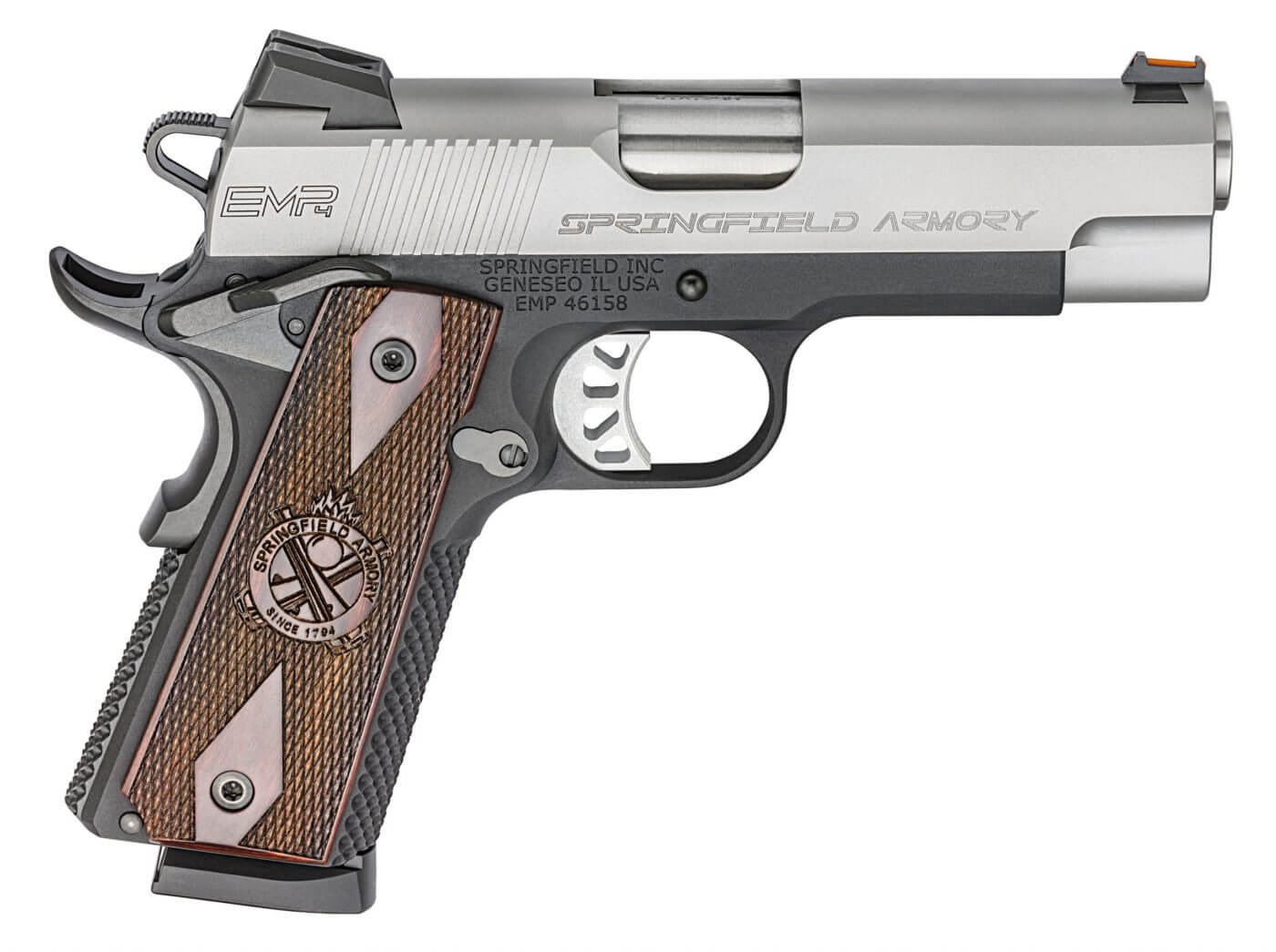
The EMP4 is suitable for tasks from CCW to IDPA to plain plinking fun. It’s not hard to see it as a platform suitable for other offshoots of the target-shooting sports. It is already sufficiently accurate to warrant adjustable sights, but target shooters might want a slightly longer sight radius. Perhaps we’ll see a longer slide and adjustable sights someday. For 2017, the big addition in the line is a model with a bobtail butt similar to Ed Brown’s. The inclusion improves concealed carry and hides the pistol more thoroughly under thin clothing.
But as it stands, the square-butt EMP4 does just about everything I want a gun to do today. And it does so better than most.
Disassembly
Let’s end pain and embarrassment (the life you save may be your own!). Remove the magazine and check the chamber ensuring the pistol is unloaded. You will need the fancy Springfield Disassembly tool provided by the company. If you’ve lost it, the now exceedingly rare paper clip substitutes admirably. If you youngsters don’t know what one is, ask someone old. They are often found in mint condition for little or no cost. 1) Pull the slide back and push up the slide stop. Insert the small part of the rod into the hole in the recoil spring guide with the long part facing the muzzle. Release the slide stop and ease the slide forward until it can be removed. Remove the slide to the front. Remove the recoil spring to the rear, capture pin and all. Do not remove the capture pin. Lift the barrel up and remove to the rear. Reassemble in reverse order.
Editor’s Note: This article was written by Jeff John and shared with us by GUNS magazine. You can see the original article here.
Also, please be sure to check out the new The Armory Life Forum, where you can comment about our daily articles, as well as just talk guns and gear. Click the “Go To Forum Thread” link below to jump in!
Join the Discussion
Featured in this article
Continue Reading
Did you enjoy this article?

 89
89




